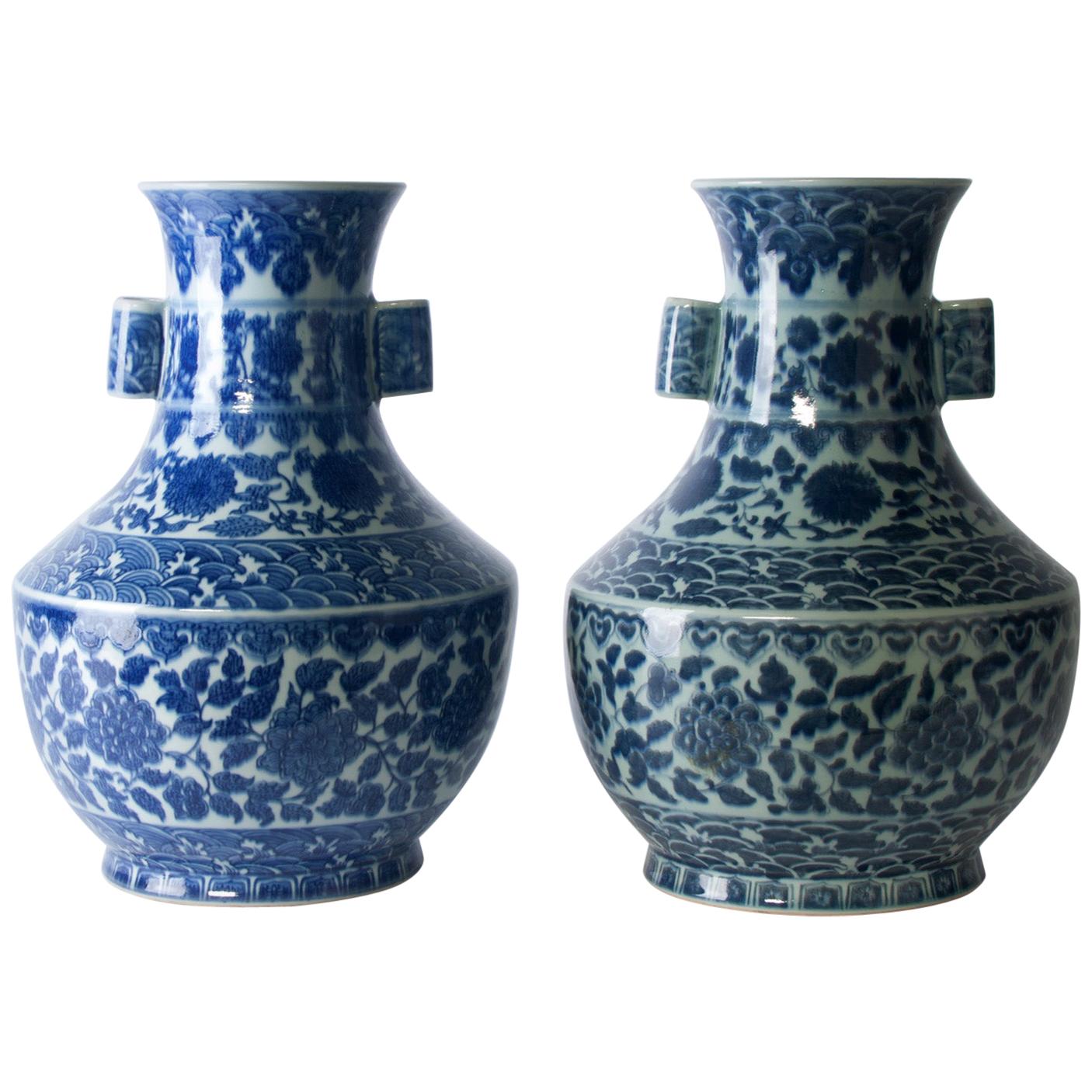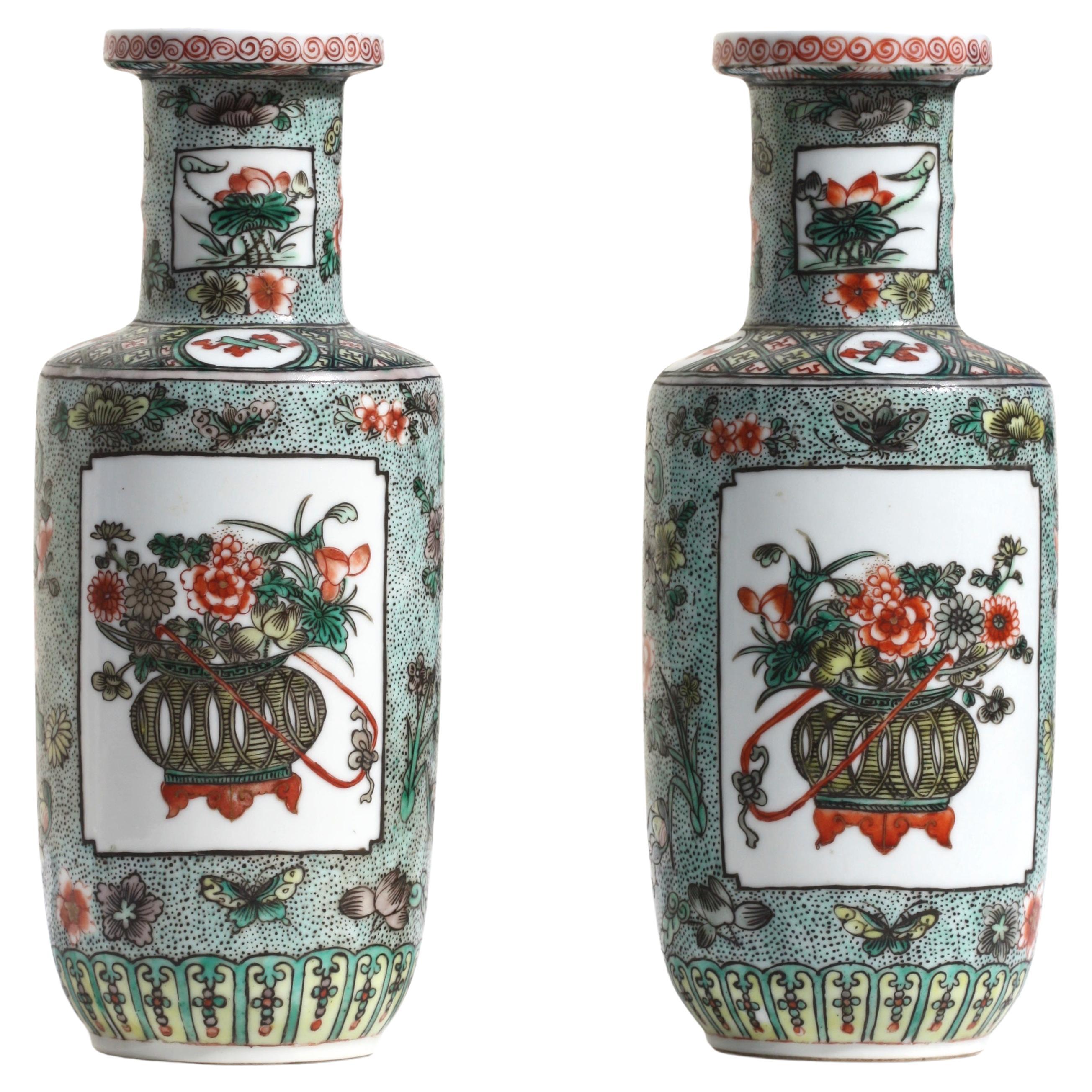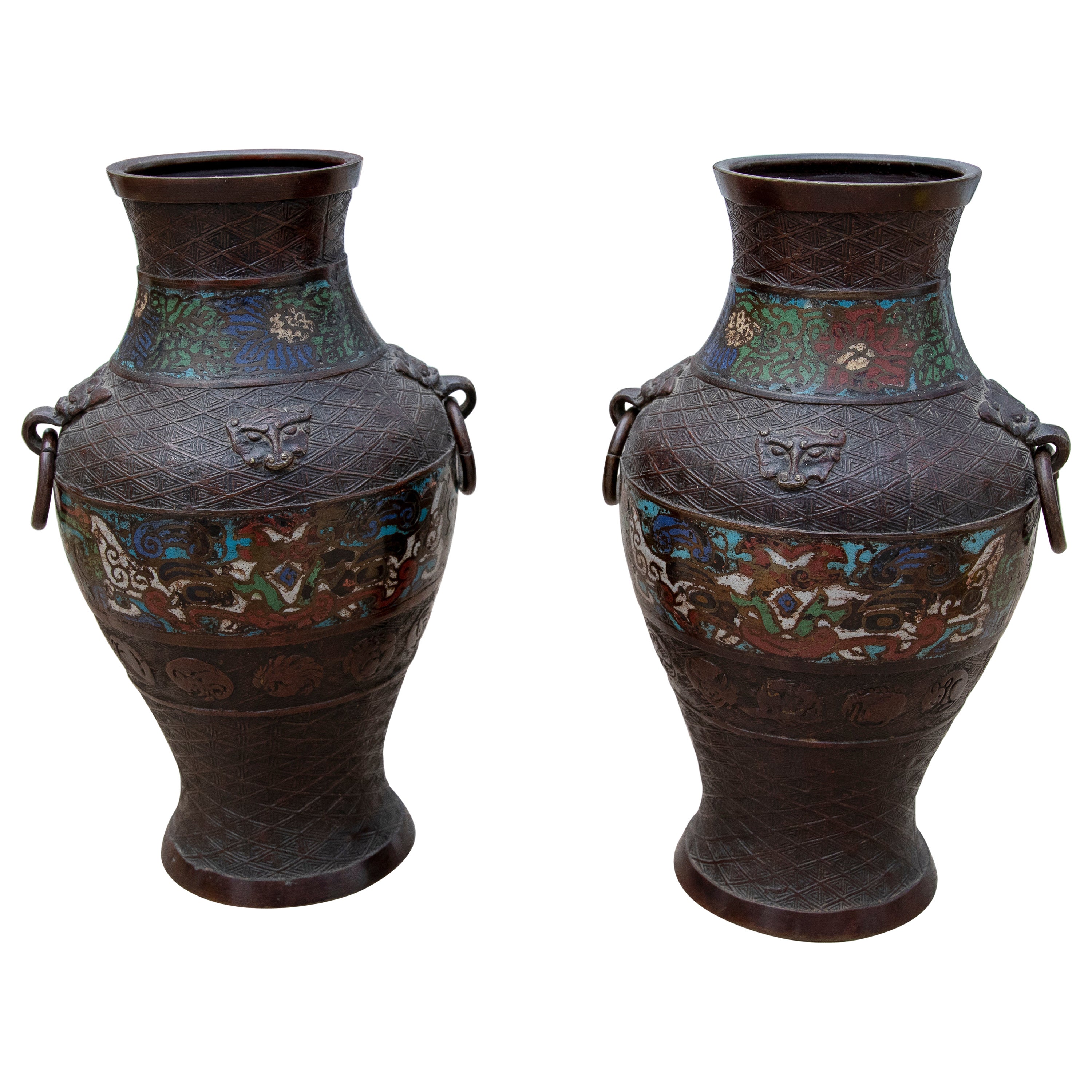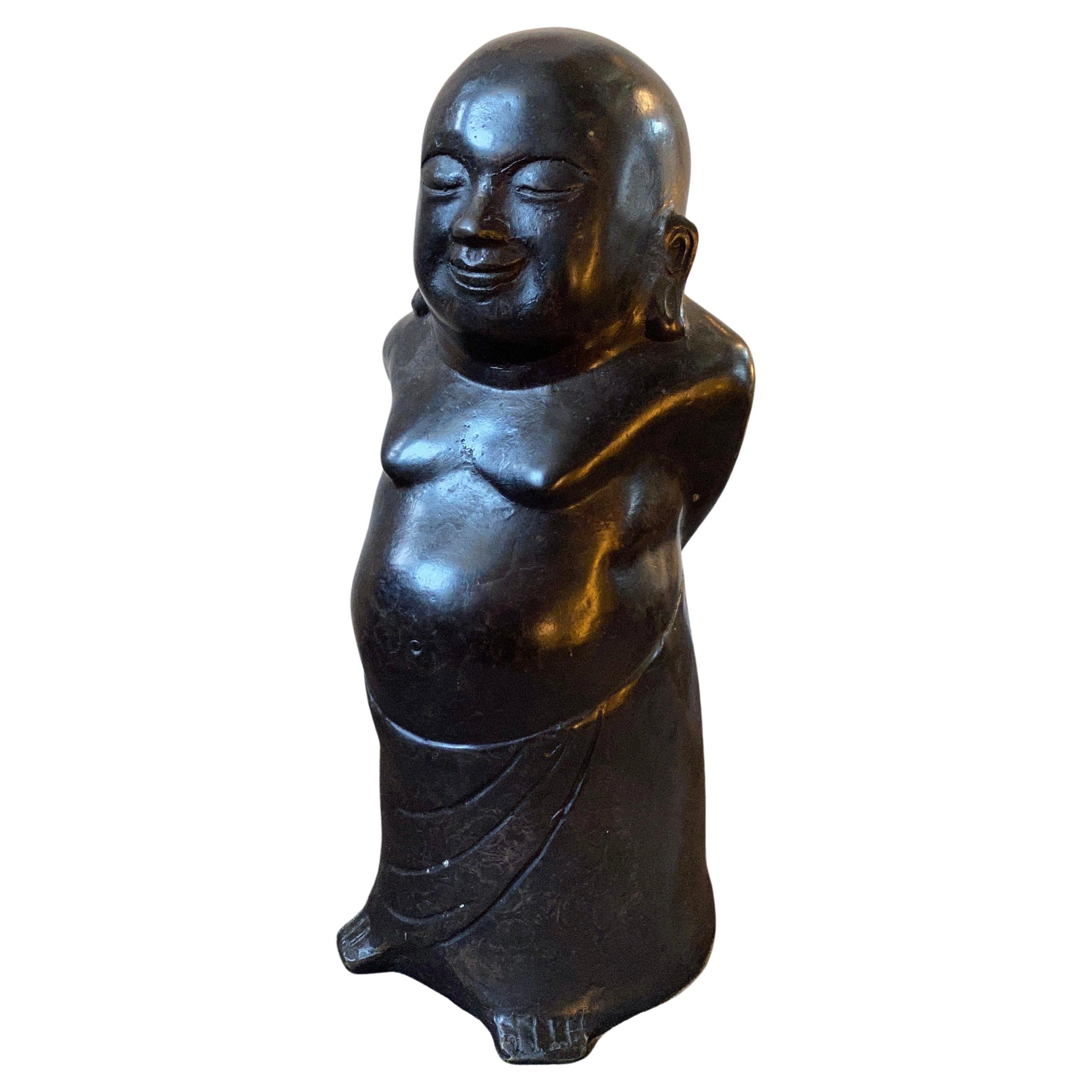Items Similar to Pair of Moon-Shaped Vases, China Late 19th Century
Video Loading
Want more images or videos?
Request additional images or videos from the seller
1 of 16
Pair of Moon-Shaped Vases, China Late 19th Century
About the Item
A pair of large moon-shaped "flasks" vases painted in blue and white, each flask decorated with scenes of active characters and surrounded by borders of floral motifs and foliate patterns. The narrow neck has Chi’en Lung motifs on the shoulders depicting a pair of dragon lug handles on a flattened cylindrical body.
Origin: The moon-shaped vases originated from the Qing dynasty (1644-1912) during the reign of Emperor Qianlong, who was also known as Chi'en Lung. They were produced in Jingdezhen, a city in Jiangxi province, which was renowned for its porcelain production.
Shape: Moon-shaped vases are characterized by their unique form, resembling a crescent moon. They have a convex body with a narrow neck and flared rim, providing a distinct visual appeal.
Blue-on-White Porcelain: The blue-on-white color scheme is a classic and iconic style of Chinese porcelain. The cobalt blue pigment was applied to the white porcelain surface before firing, resulting in a contrasting and elegant design.
Chi'en Lung Dragon Motif: The narrow neck of the vase often features a decorative motif known as the Chi'en Lung dragon. This motif represents the imperial dragon, a symbol of power, strength, and good fortune in Chinese culture. The dragon is typically depicted with a sinuous body, elongated claws, and a fierce expression.
Symbolism: Moon-shaped vases are steeped in symbolism. The crescent moon shape represents yin (feminine) energy, symbolizing receptivity and tranquility. Dragons, on the other hand, are associated with yang (masculine) energy, symbolizing strength and protection. The combination of these elements represents a harmonious balance of energies.
Artistic Skill: The production of moon-shaped vases required exceptional craftsmanship and technical expertise. Skilled artisans meticulously painted the intricate blue designs by hand, displaying their mastery in creating detailed patterns and capturing the essence of the dragon motif.
Collector's Items: Moon-shaped vases from the late 19th century are highly sought after by collectors and enthusiasts of Chinese porcelain. Their historical significance, artistic value, and limited availability contribute to their desirability in the art market.
Rarity: Due to their age and the delicate nature of porcelain, moon-shaped vases from the late 19th century are relatively rare. Surviving examples such as these in such good condition are particularly prized, as many antique pieces may have suffered damage or wear over time.
Heritage and Cultural Significance: Moon-shaped vases reflect the rich heritage and artistic traditions of Chinese porcelain. They serve as a testament to the mastery of Chinese artisans and their ability to create enduring works of art that continue to captivate admirers around the world.
- Dimensions:Height: 17.72 in (45 cm)Width: 10.63 in (27 cm)Depth: 3.94 in (10 cm)
- Sold As:Set of 2
- Materials and Techniques:
- Place of Origin:
- Period:
- Date of Manufacture:Late 19th Century
- Condition:Wear consistent with age and use.
- Seller Location:Ixelles, BE
- Reference Number:1stDibs: LU8924234981492
About the Seller
No Reviews Yet
Vetted Seller
These experienced sellers undergo a comprehensive evaluation by our team of in-house experts.
1stDibs seller since 2023
Typical response time: A week
- ShippingRetrieving quote...Ships From: Ixelles, Belgium
- Return PolicyA return for this item may be initiated within 14 days of delivery.
More From This SellerView All
- Pair of 19th Century Qing Dynasty Faux Bamboo Chinese VasesLocated in Ixelles, BEFaux bamboo Chinese vases were a type of decorative art that emerged during the Qing Dynasty (1644-1912) in China. These porcelain vases were designed to mimic the appearance of bamboo, a plant highly regarded in Chinese culture for its resilience, elegance, and symbolism. Bamboo is associated with attributes such as flexibility, strength, and modesty, making it a popular motif in Chinese art. In the Qing Dynasty the color yellow held significant symbolism and represented imperial authority, power, and the emperor himself. Yellow was considered the most sacred and prestigious color in Chinese culture, and it had strong associations with the emperor's position as the Son of Heaven and the ruler of all under heaven. The marks at the bottom of the vases indicate that these were crafted more specifically during the Tongzhi period – an emperor who reigned from 1861 to 1875, which effectively lasted nthrough his adolescence and was largly overshadowed by the rule of his mother, Empress Dowager Cixi. Although he had little influence over state affairs, the events of his reign gave rise to what historians call the “Tongzhi Restoration”, an unsuccessful modernization program. The polychrome enamels representing on one vase a traditional Chinese kite...Category
Antique Late 19th Century Chinese Chinese Export Ceramics
MaterialsPorcelain
- Pair of Late 19th Century Cantonese Famille Rose Vases in PorcelainLocated in Ixelles, BEFamille Rose refers to a type of Chinese porcelain characterized by the use of opaque, brightly colored enamels, prominently featuring shades of pink, purple, green, and yellow. The ...Category
Antique Late 19th Century Chinese Chinese Export Ceramics
MaterialsPorcelain
- 19th Century Chinese Nankin Porcelain VaseLocated in Ixelles, BENanjing Porcelain, also known as Nanking Porcelain and referred to as "Nanjing" by Western dealers in the 19th century, was a type of Chinese porcela...Category
Antique 19th Century Chinese Chinese Export Ceramics
MaterialsPorcelain
- Large Pair of Graduated Turquoise Porcelain Foo Dogs. Chinese Circa 1880Located in Ixelles, BEChinese turquoise-colored porcelain foo dogs from circa 1880 are exquisite examples of traditional Chinese ceramic art. Foo dogs, also known as guardian lions or temple lions, are ic...Category
Antique Late 19th Century Chinese Qing Ceramics
MaterialsCeramic
- Pair of Japanese Moriage Satsuma Vases with Gold Gilding Circa 1930-1940Located in Ixelles, BEJapanese Satsuma vases from the circa 1930-1940 period are a particular style of ceramic art that originated from the Satsuma province of Japan. Satsuma ware is renowned for its intricate hand-painted designs, rich colors, and distinctive crackled glaze. Satsuma ware dates back to the early 17th century, but it gained widespread popularity in the late 19th and early 20th centuries, including the 1930s and 1940s. Satsuma vases produced during this time often reflected a mix of traditional and modern influences, as Japan went through a period of cultural exchange and artistic experimentation. Satsuma vases are made from a type of Japanese earthenware clay known for its fine texture and malleability. The vases are hand-formed or wheel-thrown and then meticulously hand-painted with intricate designs using enamel paints. The distinctive crackled glaze was achieved by firing the vases at a relatively low temperature, allowing the glaze to crack during the cooling process. The moriage technique involves applying three-dimensional, raised ornamentation to the surface of the ceramic piece, creating a visually textured and layered effect. Artisans create three-dimensional patterns, designs, or intricate motifs using a special mixture of clay, slip, or porcelain paste. The raised elements are added by hand to the ceramic body, and each detail is carefully shaped to achieve the desired effect. The moriage is then gold gilded as some of the intricate ornamental patterns and the halos around the three immortal...Category
Early 20th Century Japanese Showa Ceramics
MaterialsPottery
- Marc Clauzade Painting of Saint Tropez Ref 086By Marc ClauzadeLocated in Ixelles, BEMarc Clauzade: Capturing the Essence of French Artistry Hailing from the vibrant city of Paris, Marc Clauzade stands as France’s most prominent living artistic asset, a testament to...Category
Late 20th Century French Paintings
MaterialsCanvas, Paint
You May Also Like
- 19th Century Chinese VasesLocated in Esbeek, NLBeautiful 19th century vases.Category
Antique Late 19th Century Chinese Vases
MaterialsPorcelain
- Pair of Chinese Famille Verte Porcelain Vases 19th CenturyLocated in West Palm Beach, FLA pair of Chinese famille verte porcelain vases 19th century Of rouleau form, painted with reserves of flower baskets. Height 9.75...Category
Antique 19th Century Antiquities
MaterialsCeramic
- 19th Century Chinese Pair of Bronze Vases with Cloissoné TechniqueLocated in Marbella, ES19th Century Chinese pair of bronze vases with Cloissoné Technique.Category
Antique Mid-19th Century Chinese Antiquities
MaterialsBronze
- Late 19th Century Bronze Chinese Buddha SculptureLocated in Catania, SiciliaAn high quality bronze sculpture of Buddha hand-crafted in China in late 19th century. It has normal signs of use and age.Category
Antique Late 19th Century Chinese Chinese Export Antiquities
MaterialsBronze
- Late 19th Century Elmwood Console China ExportLocated in Brescia, ITThis elegant elmwood console is handcrafted and so the beautiful details under the top and to the corners, both the sides. This is a piece of glamorous timeless The top is in solid...Category
Antique Late 19th Century Chinese Chinese Export Console Tables
MaterialsElm
- Pair Of Chinese Cloisonne Gilt Bronze Dragon Incense Burners, Late 19th CenturyLocated in Islamabad, PKThis magnificent pair of 19th-century Chinese gilt cloisonné bronze incense burners is a testament to the artistry and craftsmanship of the peri...Category
Antique 19th Century Chinese Qing Antiquities
MaterialsBronze
Recently Viewed
View AllMore Ways To Browse
Antique Moon Flask
Antique Chinese Moon Flasks
Blue And White Moon Flask
Blue Moon Flask
Chinese Flask Vase
Vintage Good Luck Bear
Silver Meiji Chrysanthemum Bowl
Bien Hoa
Antique Dagger Knife
Uran Glass
Yak Horn
Vintage Hanten
Jade Belt Hook
R D Lab
Anatolian Idol
Antique Korean Ginger Pot
Antique Korean Mirror Box
Antique Tibetan Ritual Bell





